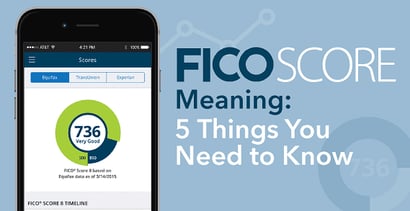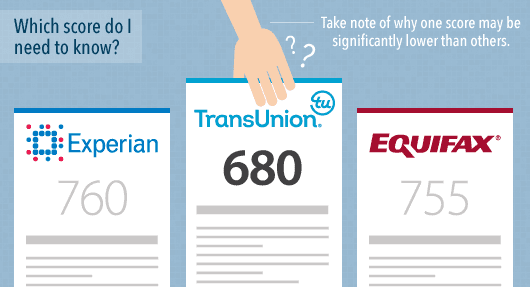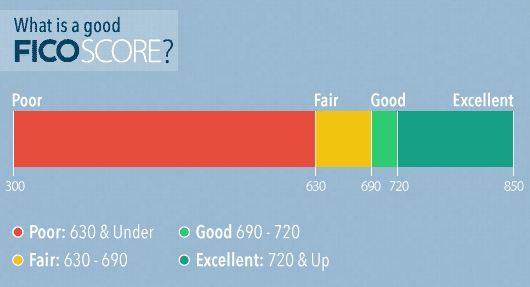

FICO is the original and most widely used credit score by lenders. According to the FICO website, 90 of the top 100 largest U.S. financial institutions use FICO Scores to determine creditworthiness (whether or not you’ll be approved for the loan you’re applying for). FICO is an acronym for Fair Isaac Corporation, the company that created the first credit scoring model in 1958.
Your FICO Score is just one of many types of credit scores. Even FICO has multiple versions depending on the type of credit being applied for. The most commonly used score is the FICO Score 8 model.
Now we’ll explain how your FICO Score 8 is determined:
1. FICO Scores Measure Credit on a Scale of 300-850
Every credit score, whether it’s the FICO model or another credit scoring model, is typically calculated by the same factors contained in your credit report from each of the three bureaus (Equifax, Experian, and TransUnion): payment history, amounts owed, length of credit history, types of credit, and new credit.

These are the percentages the FICO Score 8 model uses to calculate scores.
Here is how FICO calculates scores:
- Payment History: 35%
This category is determined by on-time and late payments. This is the most heavily weighted factor in your credit history, so paying your monthly statement before the due date is VERY important.
- Amounts Owed: 30%
This is your credit-to-debt ratio, or rather how much you owe compared to how much available credit you have.
Example: If you have a credit card with a $1,000 limit and you owe $500, you have a 50 percent utilization rate. Typically a good credit-to-debt ratio is less than 30 percent.
- Length of Credit History: 15%
This is how long your credit accounts have been established. The longer an account has been opened and in good standing, the better. The ages of all of your open accounts are taken into consideration, as well as the time since a card has been used.
- Types of Credit: 10%
Credit cards, mortgages, auto loans, school loans, etc. — these are all different types of credit. The number of types and which types are all considered. While you may have heard that credit cards are “bad,” people who do not have credit cards are seen as a higher risk to lenders than those who use them responsibly.
- New Credit: 10%
These are any recent lines of credit that have been opened. Opening too many new accounts within a short amount of time will affect your score negatively.
2. You Have FICO Scores From Experian, Equifax & TransUnion
You have three primary FICO Scores, one from each bureau: Experian, Equifax, and TransUnion. It’s beneficial to know all three scores because each bureau has its own record of your credit history (aka your credit report) and lenders may only report to one or two of the bureaus.
Usually the information is pretty consistent and your scores from each bureau should be close in range. However, if one score is significantly less than another, pull that bureau’s report to see the negative mark that is impacting that score.

Get your FICO Score from all three bureaus. You may find one to be lower, and you’ll need to know why.
As for the type of credit score, purchasing your three FICO Scores specifically is your best bet. You can use Credit Karma, Mint, or any other free service, but the credit scores they are providing you are not FICO Scores (and likely not what a lender uses) and are only for educational purposes.
View our Credit Report and Score Comparison Chart to see what sites offer what scores and reports so you know exactly what you’re getting and at what cost.
3. Different Scoring Models Don’t Weigh Info the Same
While every credit score is generally calculated by the same factors listed above, not all credit scoring models weigh that information the same, and different models have different scoring ranges.
Some of the more common credit scoring models include each of the bureau’s own models, such as the Experian PLUS Score, Equifax Credit Score, TransUnion TransRisk Score, and the VantageScore, which was created by all three bureaus to compete with the FICO Score.
The scoring ranges for each are as follows:
- Base FICO Score: 300–850
- Equifax Credit Score: 280–850
- TransUnion TransRisk: 300–850
- VantageScore: 300–850
4. A Good FICO Score is Anything Above 690
The higher the number, the better. That being said, it is generally understood that a FICO Score above 720 is considered “excellent” credit.

A high FICO Score means a better likelihood of being approved for a loan and receiving better interest rates.
A score of 690–720 is considered “good,” 630–690 is “fair” and anything below 630 is considered “poor,” though MyFico.com advises that no specific number makes an individual a “good” or “bad” customer:
“While many lenders use FICO® Scores to help them make lending decisions, each lender has its own strategy, including the level of risk it finds acceptable for a given credit product. There is no single ‘cutoff score’ used by all lenders and there are many additional factors that lenders use to determine your actual interest rates,” according to MyFico.com.
5. Your FICO Scores Change Over Time
As your credit usage and accounts change over time, so will the information on your credit reports, therefore so will your score.
It is important to obtain your credit reports regularly to monitor for any fraud or negative marks that are impacting your score. The government recommends obtaining your credit report at least once annually from AnnualCreditReport.com, the only truly free source for credit reports.
Be advised that neither FICO Scores nor other credit scores are included, so it’s in your best interest to purchase your three FICO Scores when getting your annual credit report or any time before applying for a loan to see where you currently stand and what you will qualify for.
View this chart to find where to get your FICO Scores.
Advertiser Disclosure
BadCredit.org is a free online resource that offers valuable content and comparison services to users. To keep this resource 100% free for users, we receive advertising compensation from the financial products listed on this page. Along with key review factors, this compensation may impact how and where products appear on the page (including, for example, the order in which they appear). BadCredit.org does not include listings for all financial products.
Our Editorial Review Policy
Our site is committed to publishing independent, accurate content guided by strict editorial guidelines. Before articles and reviews are published on our site, they undergo a thorough review process performed by a team of independent editors and subject-matter experts to ensure the content’s accuracy, timeliness, and impartiality. Our editorial team is separate and independent of our site’s advertisers, and the opinions they express on our site are their own. To read more about our team members and their editorial backgrounds, please visit our site’s About page.




